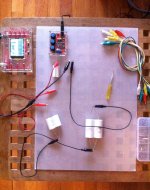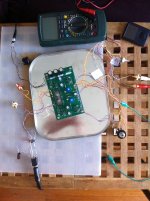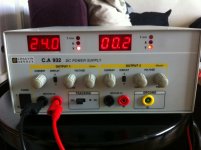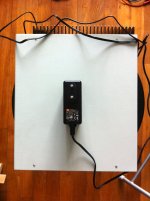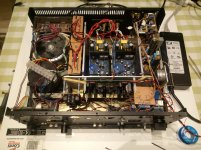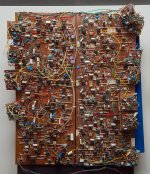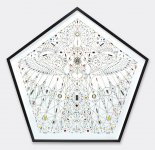While running-in the PPP caps for my last test to come, I couldn’t help enjoying the B1 KORG and trying to memorise its sound. Apart from not liking coupling caps, pre amps with gain, I am (well, was…) also biased against SMPS, being a old fan of conventional PS.
Papa advised for a very convenient wall wart SMPS, and I see no reason not to follow his advice (non expensive, easy, remote position, precisely regulated, standard item).That was just a spoiler!
Having said that, I use for some tests my old lab-PS, non-switching but regulated, a true working horse with 2 x 3A… it was just too tempting not to try it. I have to say this comparison is absolutely not fair as my lab PS is 50 times bigger, 50 times heavier, much noisier from the outside and new it cost probably 40 times more (and used it is hard to fing at less than 5 times the SMPS new price). This is not a suitable solution, just an example of how a good old conventional regulated overdimmensionated PS could perform. This is an old quality unit, probably around 317, so of course you could improve nowadays on shunt regulators (see Salas !)
TBH, mind being twisted, I really wished I could hear a difference, but as switching between the 2 PS is very easy, I have to confess that I had to listen carefully on normal music material, believed initialy I heard a small difference, but when digging deeper it turned out there wasn’t really one. It is that close.
There was a little something though, like a slight different sonic signature, but couldn’t define it nor tell which one was better, so I went to completely artificial music (JMJ’s Metamorphoses) to try define what would happen with deep electronic bass and high pitch sonic effects. When doing so, after some long listening, I came to the conclusion that the big PS has a tad more impact in the bass, a bit more drive, but also sounded somewhat darker generaly speaking over the range and less differentiated, both between bass notes and also because the bass was probably masking the other ranges. There was though that better impulse. My low ripple SMPS (which perhaps benefits a bit more from the upgraded PS filtering caps than my big PS) performed very close everywhere, hard to tell the difference, but somewhere it was clearer, more differentiated over all frequencies. Both including the SMPS have absolutely no problem in the treble, nor are they producing PS noise (well, though the B1 KORG, as the big PS unit itself produces quite a small Bzz).
It is difficult to say which one is right, more a matter of taste at that level I guess, but in that particular configuration all in all I thing I prefer Papa’s SMPS solution as being more agile with music, more subtle, less fatiguing / more natural (!), and that is balancing in my eyes the slight loss of a really tiny bit of extra impulse speed in the deepest bass regions, eventhough I enjoyed that one very much.
So, what a discovery : Papa was dead right again, LOL ! That SMPS wall wart is not a big compromise and really very goood VFM : it does the job indeed very very well.
I don’t know if a more modern DIY shunt regulator can gain on the sonic qualities of the tried SMPS, perhaps improving on that extra bass kick but then without thickering it. Perhaps someone could run test with a Salas shunt regulator vs my proposed low ripple SMPS, but IMHO this is not an aera where much can be gained and things are probably left as they are for most of us, unless you find a simple, non expensive and reliable alternative or have one already handy.
I guess you have noticed I am also a big fan of Nick / Salas work : my next project will be one of his RIAA pre-preamp, but that will have to wait for the final B1 KORG test around the PPP caps
I hope this is useful
Claude
Papa advised for a very convenient wall wart SMPS, and I see no reason not to follow his advice (non expensive, easy, remote position, precisely regulated, standard item).That was just a spoiler!
Having said that, I use for some tests my old lab-PS, non-switching but regulated, a true working horse with 2 x 3A… it was just too tempting not to try it. I have to say this comparison is absolutely not fair as my lab PS is 50 times bigger, 50 times heavier, much noisier from the outside and new it cost probably 40 times more (and used it is hard to fing at less than 5 times the SMPS new price). This is not a suitable solution, just an example of how a good old conventional regulated overdimmensionated PS could perform. This is an old quality unit, probably around 317, so of course you could improve nowadays on shunt regulators (see Salas !)
TBH, mind being twisted, I really wished I could hear a difference, but as switching between the 2 PS is very easy, I have to confess that I had to listen carefully on normal music material, believed initialy I heard a small difference, but when digging deeper it turned out there wasn’t really one. It is that close.
There was a little something though, like a slight different sonic signature, but couldn’t define it nor tell which one was better, so I went to completely artificial music (JMJ’s Metamorphoses) to try define what would happen with deep electronic bass and high pitch sonic effects. When doing so, after some long listening, I came to the conclusion that the big PS has a tad more impact in the bass, a bit more drive, but also sounded somewhat darker generaly speaking over the range and less differentiated, both between bass notes and also because the bass was probably masking the other ranges. There was though that better impulse. My low ripple SMPS (which perhaps benefits a bit more from the upgraded PS filtering caps than my big PS) performed very close everywhere, hard to tell the difference, but somewhere it was clearer, more differentiated over all frequencies. Both including the SMPS have absolutely no problem in the treble, nor are they producing PS noise (well, though the B1 KORG, as the big PS unit itself produces quite a small Bzz).
It is difficult to say which one is right, more a matter of taste at that level I guess, but in that particular configuration all in all I thing I prefer Papa’s SMPS solution as being more agile with music, more subtle, less fatiguing / more natural (!), and that is balancing in my eyes the slight loss of a really tiny bit of extra impulse speed in the deepest bass regions, eventhough I enjoyed that one very much.
So, what a discovery : Papa was dead right again, LOL ! That SMPS wall wart is not a big compromise and really very goood VFM : it does the job indeed very very well.
I don’t know if a more modern DIY shunt regulator can gain on the sonic qualities of the tried SMPS, perhaps improving on that extra bass kick but then without thickering it. Perhaps someone could run test with a Salas shunt regulator vs my proposed low ripple SMPS, but IMHO this is not an aera where much can be gained and things are probably left as they are for most of us, unless you find a simple, non expensive and reliable alternative or have one already handy.
I guess you have noticed I am also a big fan of Nick / Salas work : my next project will be one of his RIAA pre-preamp, but that will have to wait for the final B1 KORG test around the PPP caps
I hope this is useful
Claude
Attachments
Grounding…
My B1 KORG is not yet in a casing, being used for tests and final decisions is not yet taken on the final layout. I don’t expect it therfore to behave YET perfectly under all conditions, especialy with all these wires etc.
It is a very quiet unit, no noise, but « sometimes on some days », when not listening to music and turning up the volume quite a lot while using headphones, I can hear a small ground noise. That is with or without source connected, regardless the PS I use and it completely disapears when I touch the mass wire I left open for that purpose (what a nice antenna that must be) with my finger. The noise gets very loud if I touch the body of the potentiometer or some other bits I shouldn’t touch (LOL), but generaly speaking it is small – but it can rob some music for my listening tests hence me having that wire to connect myself to ground. I have to say it depends also on weather as of today there was no noise at all while it rained and being connected to ground didn’t change anything at all, everything was perfect regardless what Idid or didn’t.
Now, I know this ground problems can be troublesome so I wonder if there is a cure – or if I shouldn’t bother at all with a casing, well noting it might come in a wood box one day but that can have a shield etc. if advised.
What I noticed with the completely exposed B1KORG was that with that many wires it could be sensitive on some days, but again me touching mass (with or without shoes) cures it immediately. But once it will come into a nice box, wood or metal, I won’t be able to run a wire between me and this nice pre « in case of », LOL !
What I noticed though was that since I put a metal plate under the B1 KORG, with its 4 metal stand offs touching it (they are at mass), things tended to improve a bit, the noise when appearing being even less noticeable. But I KNOW it CAN be there sometimes.
Lines are connected directly and switched only, masses are running from RCA to RCA to a single star point (that is yet flying but that will presumably be connected to the casing) from where on all other mass wires run to the Korg. I have tried connecting this star point to my metal plate under the Korg but that doesn’t change anything.
It is of no concern now as the cure during my tests is simple : I just connect to a wire whenever needed. It is not really noticeable when music is playing anyway. BUT I would like to know if I should plan for something once it comes into a casing, if I have to bother or already think of some additional parts (resistor ?) or a given (read « proper » connection schema…
Thanks for your help !
Claude
My B1 KORG is not yet in a casing, being used for tests and final decisions is not yet taken on the final layout. I don’t expect it therfore to behave YET perfectly under all conditions, especialy with all these wires etc.
It is a very quiet unit, no noise, but « sometimes on some days », when not listening to music and turning up the volume quite a lot while using headphones, I can hear a small ground noise. That is with or without source connected, regardless the PS I use and it completely disapears when I touch the mass wire I left open for that purpose (what a nice antenna that must be) with my finger. The noise gets very loud if I touch the body of the potentiometer or some other bits I shouldn’t touch (LOL), but generaly speaking it is small – but it can rob some music for my listening tests hence me having that wire to connect myself to ground. I have to say it depends also on weather as of today there was no noise at all while it rained and being connected to ground didn’t change anything at all, everything was perfect regardless what Idid or didn’t.
Now, I know this ground problems can be troublesome so I wonder if there is a cure – or if I shouldn’t bother at all with a casing, well noting it might come in a wood box one day but that can have a shield etc. if advised.
What I noticed with the completely exposed B1KORG was that with that many wires it could be sensitive on some days, but again me touching mass (with or without shoes) cures it immediately. But once it will come into a nice box, wood or metal, I won’t be able to run a wire between me and this nice pre « in case of », LOL !
What I noticed though was that since I put a metal plate under the B1 KORG, with its 4 metal stand offs touching it (they are at mass), things tended to improve a bit, the noise when appearing being even less noticeable. But I KNOW it CAN be there sometimes.
Lines are connected directly and switched only, masses are running from RCA to RCA to a single star point (that is yet flying but that will presumably be connected to the casing) from where on all other mass wires run to the Korg. I have tried connecting this star point to my metal plate under the Korg but that doesn’t change anything.
It is of no concern now as the cure during my tests is simple : I just connect to a wire whenever needed. It is not really noticeable when music is playing anyway. BUT I would like to know if I should plan for something once it comes into a casing, if I have to bother or already think of some additional parts (resistor ?) or a given (read « proper » connection schema…
Thanks for your help !
Claude
Jfet comparison followup for Acousticer83 and Rewind
My first B1 Korg was the Xmas version with Toshibas. I recently built a diyAudio store V1R0 version with Fairchilds for a friend. All electronic components were identical except for the Jfets.
I did a careful A-B listening test with a CD player bridged into both preamps and the preamp outputs on a toggle switch. Output gains were set to be identical.
At first I thought I heard a slight improvement in smoothness of the upper range of the Toshiba unit. When I checked both units, I realized the plate voltages were 9.5 on the Fairchild unit and 9.7 on the Toshiba unit.
Once I set the Fairchild unit's plates to 9.7 to match the Toshibas, I could detect absolutely no difference in the sound characteristic between the two units.
As a final note, I bought 2 dozen J113s from Mouser thinking I could build some other circuits by matching them myself. Not only were the Idss values all over the board with very few within 1 mA of each other, the lowest Idss was about 12 mA. Pretty useless if you are looking for 6 to 10 mA. So the PCB with matched Fairchild Jfets and resistors from the diyAudio store is an exceptional value and highly recommended.
My first B1 Korg was the Xmas version with Toshibas. I recently built a diyAudio store V1R0 version with Fairchilds for a friend. All electronic components were identical except for the Jfets.
I did a careful A-B listening test with a CD player bridged into both preamps and the preamp outputs on a toggle switch. Output gains were set to be identical.
At first I thought I heard a slight improvement in smoothness of the upper range of the Toshiba unit. When I checked both units, I realized the plate voltages were 9.5 on the Fairchild unit and 9.7 on the Toshiba unit.
Once I set the Fairchild unit's plates to 9.7 to match the Toshibas, I could detect absolutely no difference in the sound characteristic between the two units.
As a final note, I bought 2 dozen J113s from Mouser thinking I could build some other circuits by matching them myself. Not only were the Idss values all over the board with very few within 1 mA of each other, the lowest Idss was about 12 mA. Pretty useless if you are looking for 6 to 10 mA. So the PCB with matched Fairchild Jfets and resistors from the diyAudio store is an exceptional value and highly recommended.
Yes, I get matches because I have about 160,000 of them. They get sorted by
lot code, then by Vp and then Idss. It's a little tedious, but if the parts are matched
up to resistors, a CCS can be obtained over a nice range of values.
The transconductance of these parts is largely independent of the Idss, so
biasing any of them at a given Ids gives consistent performance.
lot code, then by Vp and then Idss. It's a little tedious, but if the parts are matched
up to resistors, a CCS can be obtained over a nice range of values.
The transconductance of these parts is largely independent of the Idss, so
biasing any of them at a given Ids gives consistent performance.
I was very near buying 1000 pcs J113 to be able to find some matches for future builds. Here the 1000 pcs price is about 10 cent pr. transistor. Probably the expensive 2SK170 was about or cheaper years ago. Maybe J113 go up in price when they are no loger produced?  …..then we can sell them on ebay…..
…..then we can sell them on ebay…..
Uuuuuuffffffff!!!!!
I am back.
I soldered the matched fets, cleaned the board, installed a resistor pot, a direct input, (no pot), and a nice flat yellow led.
Everything wired with solid silver, insulated. All contacts isolated.
I measured and...
EVERYTHING IS OK!!
R1s are 0,7, 0,72...
I will post the exactly measurings later, and after hearing it.
I think that the Nutubes are "bluer" than before.
It's family time, cant' hear it now.
"C'est l'heure de l'apérot".
I'll come back tomorrow.
I am very happy with the results and can't wait to hear it.
I am back.
I soldered the matched fets, cleaned the board, installed a resistor pot, a direct input, (no pot), and a nice flat yellow led.
Everything wired with solid silver, insulated. All contacts isolated.
I measured and...
EVERYTHING IS OK!!
R1s are 0,7, 0,72...
I will post the exactly measurings later, and after hearing it.
I think that the Nutubes are "bluer" than before.
It's family time, cant' hear it now.
"C'est l'heure de l'apérot".
I'll come back tomorrow.
I am very happy with the results and can't wait to hear it.
Last edited:
I know this is out of topic, I apologise, but...
I am desperate searching 6 Toshiba 2SJ313's matched for Vgs at 10 mA.
This is for an Aleph III that I am finishing - 3 per board.
I know I know, this is an "old" amp, but I want to finish it
and old project does not mean not good.
Does anyone knows where to buy these Jfets, matched like this?
I can make an exchange. Psu, dac, caps...or buy it.
I have very nice psu boards, dac, etc etc. Help! Let me give you a gift.
Thank you!!
I am desperate searching 6 Toshiba 2SJ313's matched for Vgs at 10 mA.
This is for an Aleph III that I am finishing - 3 per board.
I know I know, this is an "old" amp, but I want to finish it
and old project does not mean not good.
Does anyone knows where to buy these Jfets, matched like this?
I can make an exchange. Psu, dac, caps...or buy it.
I have very nice psu boards, dac, etc etc. Help! Let me give you a gift.
Thank you!!
Dear Nelson, please be reminded that your effrots in matching parts is appreciated daily around the globe! I'm listening right now and loving it. The board is still held in position with elastic bands, it rings like a bell when I change input and I have no idea where the voltages have settled after the 2 month its been playing. I just don't want to unplug it and stop the music!Correction. It's a LOT tedious.

Thank you
Attachments
- Home
- Amplifiers
- Pass Labs
- B1 with Korg Triode
